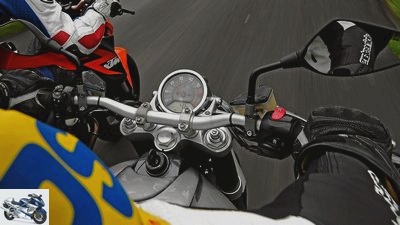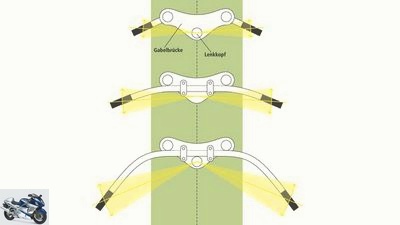Table of contents
- Handlebars for various types of motorcycle Advantages and disadvantages of different handlebar shapes
- Tall stub handlebars
- Deep stub handlebars
- Tubular handlebars (series handlebars)
- Enduro handlebars (series handlebars)
- Superbike handlebars (series handlebars)
- Dragbar (series handlebar)
- Beach Bar (accessory handlebar)
- Apehanger (accessory handlebar)
- opinion poll

Markus Jahn.
accesories
Handlebar: Which shape suits your motorcycle and riding style?
Handlebars for various types of motorcycle
Advantages and disadvantages of different handlebar shapes
Which motorcycle handlebar fits which driving style and which motorcycle? We show all the advantages and disadvantages of the different handlebar shapes.
Manuel Fuchs
06/10/2019
There are three main factors that determine how a motorcycle feels when you steer it. Firstly, the handlebar width: the further apart the rider’s hands are, the longer the lever with which he initiates the steering commands into the motorcycle. A long lever means that although relatively little force is required, the hand has to travel a long way. With a short lever, i.e. with narrow tubular handlebars and stubs, it is the other way round: short travel, great power.
Secondly, the three-dimensional bend of the handlebars, the so-called cranking, plays a role: most drivers find the handlebar ends slightly bent backwards and inclined downwards as comfortable. Experiments are worthwhile here: Loosen the screws of the handlebar clamp, twist the handlebars slightly, do not kink or pinch any cables or hoses, tighten the screws and try out the result.

MOTORCYCLE
Important factors for a comfortable driving experience: The shape and the offset of the handlebars.
Thirdly, the closer the imaginary line is between the hands to the steering head bearing, the more precise the steering feels. In one extreme case, with clip-on handlebars, you think you are holding the axle of the front wheel yourself. At the other extreme are wide cruiser handlebars that are pulled far back; they steer the motorcycle more indirectly, more like a wheelbarrow. One more thing: a driver who sits wide and upright, possibly with a fluttering station wagon in the airstream, unconsciously initiates steering impulses into the vehicle at high speed, which then becomes restless. A very narrow, deep handlebar reduces this effect, but it forces the driver into a position from which he can see little of the traffic. As is so often the case, the best compromise is a question of personal driving style.
Tall stub handlebars
- Typical for: Sporty touring motorcycles such as the Honda VFR 1200 F, BMW K 1300 S, Kawasaki 1400 GTR and Triumph Sprint GT
- Positive: Allow the driver a reasonably aerodynamic, but still comfortable posture with an overview of the traffic.
- Negative: Requires relatively high steering effort; additional fittings and controls are difficult to accommodate.
Deep stub handlebars
- Typical for: Sports motorcycles like Ducati 1098, BMW S 1000 RR, Honda Fireblade, Kawasaki Ninja, Suzuki GSX-R and Yamaha YZF-R1 / -R6.
- Positive: The motorcycle can be steered precisely, the rider sits compactly and offers little surface to the wind even at very high speeds.
- Negative: sitting posture requires body tension; otherwise there will be a lot of weight on the wrists. Both are exhausting. Very limited overview.
Tubular handlebars (series handlebars)
- Typical for: Naked bikes and all-rounders such as Suzuki Gladius, BMW F 800 R, Honda CBF 600, Kawasaki Z 750 and Yamaha Fazer8.
- Positive: A balance between steering forces, precision and comfort that is very suitable for everyday use. Easily varied by adjusting the clamping.
- Negative: Depending on the handlebar width and motorcycle fairing, the rider can be very susceptible to wind even at medium speed.
Enduro handlebars (series handlebars)
- Typical for: Off-road motorcycles such as the Yamaha XT 660 R, Kawasaki KLX 250, KTM Enduro 690 and Yamaha WR 250 R..
- Positive: mounted high and slightly cranked, making it easy to ride, especially when standing. A cross strut increases stability.
- Negative: Often not optimally shaped and quite wide for long stretches of the road; Drivers are therefore susceptible to interference from the airstream.
Superbike handlebars (series handlebars)
- Typical for: Sports motorcycles that are used for longer tours and are therefore to be converted for comfort.
- Positive: Allows riders of sports motorcycles to sit more comfortably, similar to that of a naked bike; lower steering forces.
- Negative: The conversion requires screwdriver experience, as the upper triple clamp often has to be replaced. The cladding must not hinder the steering angle.
Dragbar (series handlebar)
- Typical for: Powerful cruisers that want to be reminiscent of motorcycles for drag races.
- Positive: Generates a direct steering feel, with a moderate width even suitable for higher speeds.
- Negative: The fact that the driver does not have to bend to a large extent requires a sometimes strenuous, forward-leaning posture.
Beach Bar (accessory handlebar)
- Typical for: Classic cruisers and retro versions, for which coolness and being seen are more important than speed and sport.
- Positive: an upright, tension-free posture and minimal steering forces allow comfortable cruising.
- Negative: Turning maneuvers require far-reaching movements, from medium speed extremely susceptible to wind, very indirect steering feel.
Apehanger (accessory handlebar)
- Typical for: Custom bikes; also occasionally found on production motorcycles, for example the Harley-Davidson Dyna Street Bob.
- Positive: Strong appearance on the show mile, guaranteed no sweat stains under the arms (hence also called “8×4 handlebars”).
- Negative: Posture takes getting used to, allows little variation and is therefore quickly exhausting. Sensitive to wind, indirect steering feel.
opinion poll
Which handlebar is installed on your bike?
Voted 1645 times
Tall stub handlebars
Deep stub handlebars
Tubular handlebars
Enduro handlebars
Superbike handlebars
Dragable
Beach bar
Apehanger
Related articles
-
counselor workshop Vibrations in the motorcycle Vibrations in the motorcycle Vibrations in the motorcycle Commuting, flapping, banging the handlebars,…
-
Ox One: Cafe Racer style electric motorcycle
Ox Motorcycles 16 pictures Ox Motorcycles 1/16 Ox Motorcycles is a Spanish startup. Ox Motorcycles 2/16 With the Ox One, the Iberians want to bring their…
-
archive counselor technology & future Lateral and circumferential forces when riding a motorcycle – driving physics when riding a motorcycle About…
-
Selection and assembly of motorcycle handlebars
Schermer counselor workshop Selection and assembly of motorcycle handlebars Handlebar conversion on a motorcycle Selection and assembly of motorcycle…
-
New Bosch motorcycle safety systems
Bosch 17th pictures Bosch 1/17 To make motorcycling even safer, Bosch is developing numerous new assistance systems. Bosch 2/17 Motorcycles should learn…
-
Report: Riding a motorcycle in Japan
Suzuki to travel Report: Riding a motorcycle in Japan Report: Riding a motorcycle in Japan The cradle of the modern motorcycle: Through Japan by…
-
Portrait of Bernd Brand – riding a motorcycle with a prosthesis
Mayer Sports & scene Motorsport Portrait of Bernd Brand – riding a motorcycle with a prosthesis Portrait of Bernd Brand Riding a motorcycle with a…
-
New motorcycle registrations February 2018
manufacturer 20th pictures manufacturer 1/20 20th place among new motorcycle registrations in February 2018: Honda Fireblade with 63 units New…
-
White Motorcycle Concepts WMC250EV: electric speed record
White Motorcycle Concepts 15th pictures White Motorcycle Concepts 1/15 White Motorcycle Concepts wants the world speed record for electric motorcycles….
-
Kawasaki 12th pictures BMW 1/12 Norbert Klauer (58), Head of Powertrain Development at BMW Motorrad, on the possibilities and difficulties of the…